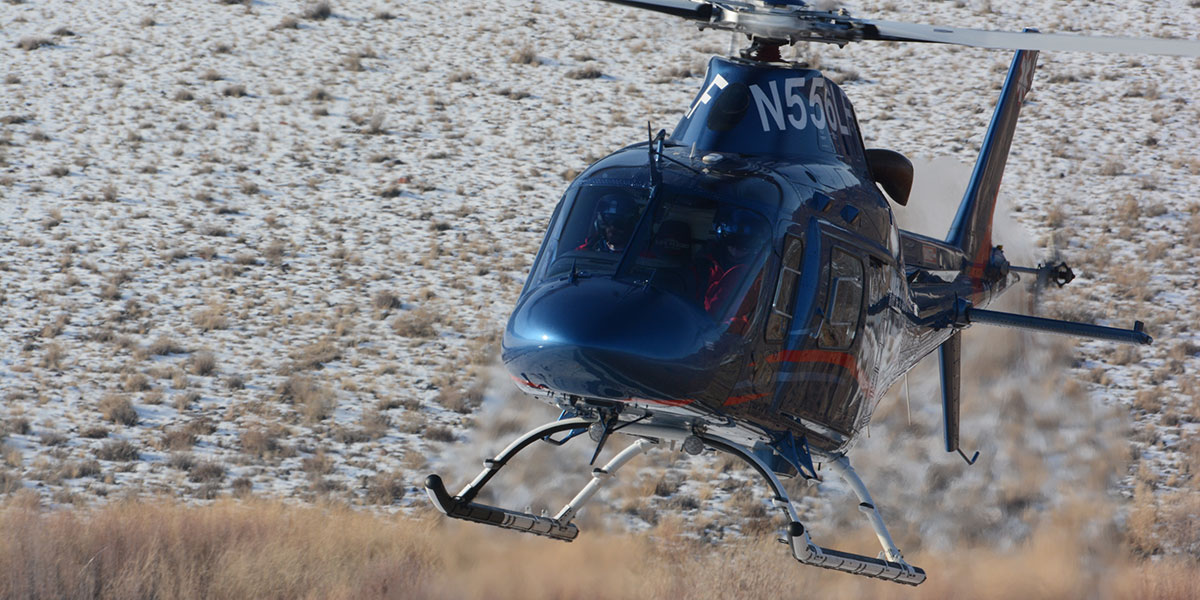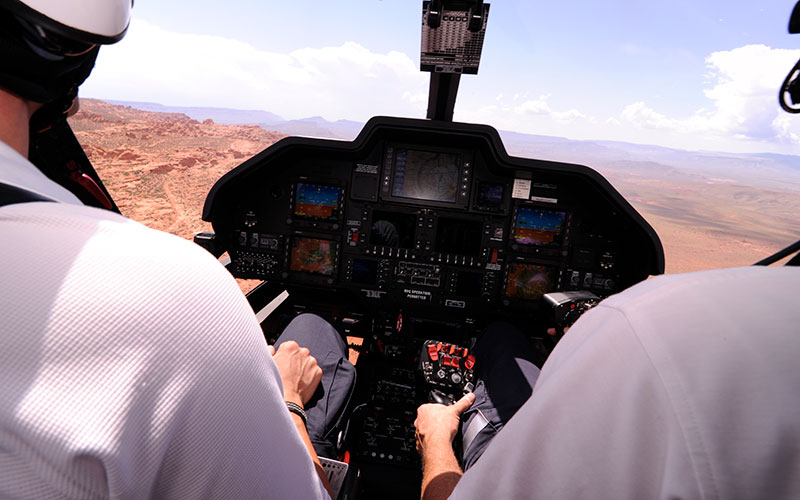Instrument Flight Rules operations for HEMS

Introducing instrument flight rules operations means increased safety for crews and patients. Barry Smith spoke to operators and training providers to find out how complicated they are to implement
One of the fundamental tenets of medicine is to do no harm. This also applies to transportation systems designed to deliver patients to higher levels of care within a reasonable amount of time. Helicopters have been used in this role for over 40 years. However, crashes involving poor weather have plagued the industry from the beginning. Using GPS technology, many helicopter EMS (HEMS) programs have developed instrument flight rules (IFR) programs to transport patients safely in poor weather.
Key take-off and landing points
The key to HEMS IFR programs is to establish approved IFR approaches and departures for hospital helipads. These are not like an airport instrument landing system where the aircraft is guided down a radio beam to the end of the runway. These IFR procedures use GPS to guide the helicopter to a point in space a certain distance and altitude from the helipad. When it reaches that point, the pilot then transitions to VFR flight, and visually lands at the pad. If the pilot cannot obtain visual contact, they conduct a missed approach and fly to an alternate destination.
Hickok and Associates of Orange Beach, Alabama, has been developing HEMS IFR procedures for over 25 years. “There has never been an accident in the US with a HEMS ship flying on an IFR-filed flight plan, while there have been many with pilots trying to make it through poor weather under VFR flight rules,” stated Stephen Hickok, President of Hickok and Associates. “The benefit is greater safety and the ability to perform more flights. Our focus is on getting an operator’s return on their investment for an IFR program to be able to use it as efficiently as possible by increasing their number of missions. Without developing GPS approaches to hospital helipads, the helicopter would have to do an IFR approach to an approved airport and meet a ground ambulance to finish the transport, which takes much more time.”
Evaluate obstacles, chart a solution
Hickok explained that the first step of the process is an on-site evaluation by his personnel. While vertical obstacles around airports are known, the obstacles around hospitals are not charted. Every potential vertical obstacle around the helipad must be precisely located so that approach routes can be developed. They start with the hospital helipad itself. The exact location, elevation, and other details are often inaccurate, or not accurate enough for IFR approach development. They then survey potential obstacles within a few miles of the hospital, noting their exact location and height.
They then begin to construct the IFR route into the heliport. Some are simple with only one route. However, others are very complicated with multiple procedures where the helicopter may need to arrive or depart from several directions such as a helicopter based at a hospital or a major medical facility such as a trauma center or specialty hospital. So, a network of IFR procedures might need to be developed. In this way, the helicopter is always on an IFR-approved route from the start of a flight to the finish, from the sending facility to the receiving facility. This can become very complex with a HEMS program that has multiple bases and many sending and receiving hospitals. Hickok stated that they may need as many as 100 procedures, or routes, from all the bases to all of the hospitals they serve and then back to the bases.
The minimum weather conditions that can be used for these IFR procedures differ from location to location, depending on terrain and obstacles
The minimum weather conditions that can be used for these IFR procedures differ from location to location, depending on terrain and obstacles. The absolute lowest altitude that can be used is 200 ft above the helipad. Hickok said their average is 250 to 500 ft, depending on the type of approach. They also have to take into account the height above the terrain of the helipad. If it is on the 20th floor of a hospital, that obviously will affect the minimum cloud ceiling of the approach and departure procedures.
“Once we design an IFR procedure, we have to get it approved by the local air traffic control facility that will end up controlling that procedure to make sure there is no conflict,” explained Hickok. “Next, flight validation is done to make sure the IFR procedures, approaches and departures, work as they were designed. The customer provides a helicopter and Hickok provides a validation pilot to fly with the customer’s pilot. The last step is to present the procedure package to the Federal Aviation Administration (FAA) for approval. Once it is approved, Hickok prints the approach and departure charts for use by the customer. Start to finish, the entire development takes from six to 18 months, depending on the complexity of the system and how long the FAA approval process takes.”

Ongoing monitoring
Hickok has invested heavily in its IFR procedures maintenance program. Once procedures have been developed and implemented, the routes must be maintained to make sure they stay safe and new potential vertical obstacles are discovered before they create a hazard. The company maintains over 800 IFR procedures and thousands of miles of IFR routes.
Every week, the FAA updates its master database of all proposed new construction (all construction projects that exceed a specific height above the ground must be reported to the FAA). Hickok has developed a suite of software programs that go through this database every week. The software has all the physical boundaries of all their IFR approaches and departures and examines the FAA database for any possible impacts from these proposed construction projects. They then report any impact to the FAA with a proposal on how to mitigate that impact.
Making each program unique
One of the more interesting IFR HEMS programs that Hickok and Associates helped create is the Dartmouth-Hitchcock Advanced Response Team (DHART), located in New Hampshire.
“We have three bases, each with an Airbus EC135P2+, situated between three different mountain ranges,” explained Kyle Madigan, Director of DHART. “It doesn’t take much weather to interfere with VFR flight operations here in the northeastern US. We also feel an IFR system is a very strong safety factor in case weather changes quickly or the crews encounter inadvertent instrument meteorological conditions (IMC) conditions. It also increases our capability to serve our community, as well as increase safety. We began IFR flights in 2008. With our weather patterns, often the mountains are in the clouds and the valleys, where the sending and receiving hospitals are located, are clear. So, we fly IFR to cross the mountains and then can descend into the valleys on IFR approaches to our destinations, break out of the clouds, and proceed to the hospital under VFR conditions.”
“In 2008 and 2009, we were predominantly flying IFR from airport to airport to pick up and deliver our patients,” stated DHART’s Aviation Site Manager Paul Austin. “We began talking with Hickok and Associates to see how we could improve our IFR program. We began by looking at our flight volumes and flight patterns and developed a list of hospitals that we serve. That list was divided into groups of 10 hospitals based on how often we flew to them and how often they encountered weather challenges. This prioritized the need to develop GPS IFR approaches for the hospitals we served. Today, we have established 33 IFR procedures, approaches and departures.”
The team has developed over 300 IFR routes that the pilots can access for flight planning in the helicopters’ navigation system
The team has developed over 300 IFR routes that the pilots can access for flight planning in the helicopters’ navigation system. This includes all the routes to and from the hospitals and airports from any of the three bases. All the IFR departure routes are extended out to meet the IFR approach routes of other destinations. So, they have created a network of departures, feeder routes, and approaches that all connect with little need to add any waypoints.
Madigan said no one has really connected IFR routes like they have here before. So, from take off to landing, they can fly their own network of IFR routes designed to maximize safety and efficiency. This allows flights up to 2,000 ft lower than the standard, established FAA IFR routes. This is important for DHART, because it allows them to fly below the icing levels found at higher altitudes in the spring and fall months.
“In addition, with our weather pattern of obscured mountains and VFR conditions in the valleys, we can fly IFR over the mountains and then descend below the clouds in the valleys using a GPS approach,” explained Austin. “Once the ship breaks out of the clouds, if the conditions are VFR, they can then cancel the IFR flight and proceed VFR to meet an ambulance for a scene call.”

Training is vital
Metro Aviation has been the aircraft and pilot vendor for the program for 26 years. New pilot training starts at the bases for the first two to three months. They are then sent to Metro Aviation’s training center for an IFR program that includes time in Metro’s Level D full motion simulator in Shreveport, Louisiana. After that initial training, every pilot performs monthly IFR training and instrument check rides every six months.
the increased safety factor of an IFR program is much more important than being able to do more flights
“If it is safe to do so, we prefer to fly VFR because it gets the patient to their destination as soon as possible,” Madigan said. “If the weather is marginal, the pilot can prepare an IFR route and file for an IFR clearance if the weather deteriorates. So, they can have that IFR route ready to go if they need it and not get into the situation of trying to squeeze under a lowering cloud base. The higher skill and experience level also allow them to safely handle sudden IMC conditions if they are encountered. So, to me, the increased safety factor of an IFR program is much more important than being able to do more flights.”
Changing regulations
Up until very recently, all US IFR HEMS programs have been using twin-engine ships because the FAA has not certified a single-engine helicopter for IFR operations. That changed when the US Navy put out a bid to replace its fleet of training helicopters. Both Bell and Leonardo certified single-engine helicopters for IFR operation with the FAA. For Bell, it was a model of their 407. For Leonardo, it was the AW119Kx. This may encourage more HEMS programs in the US to consider IFR operations using a lower-cost single-engine elicopter.
Life Link III, with bases in Minnesota and Wisconsin, has ordered one IFR-certified AW119Kx with an option for a second ship. The provider intends to create an IFR system over the next several years for all of their sending and receiving hospitals.
Flying safely and securely
AirMed&Rescue talked with several HEMS programs that have IFR programs, and the overwhelming reason for creating them was to increase safety, not patient volume. They reported the average patient transport volume increase was five per cent or less. They all stated that a program must be willing to make the financial, cultural and operational commitment to develop an IFR program. But, if they do, the overall safety for their patients and crews will be greatly improved.
- Publishing Details
-
Pilots
-
2 Nov 2020
-
Share
Barry Smith
Barry Smith has been an aviation and emergency services writer/photographer for over thirty years. He has published over 250 magazine articles and six books. He has also worked in emergency services as a paramedic, volunteer firefighter, and member of search and rescue teams for over 40 years.